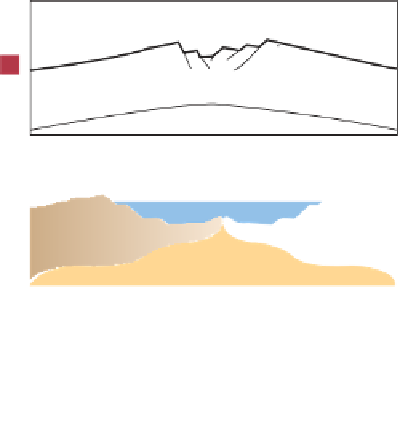Geology Reference
In-Depth Information
or erupted onto existing continental crust. These igneous
rocks are exposed in eastern Canada, extend across Green-
land, and are also found in the Baltic shield of Scandinavia.
However, they are deeply buried in most areas.
The origins of these granitic and anorthosite* plutons,
calderas and their fill, and vast sheets of rhyolite and ash
flows are the subject of debate. According to one hypoth-
esis, large-scale upwelling of magma beneath a Proterozoic
supercontinent was responsible for these rocks. According to
this hypothesis, the mantle temperature beneath a Protero-
zoic supercontinent would have been considerably higher
than beneath later superconotinents because radiogenic heat
production within Earth has decreased. Accordingly, non-
orogenic igneous activity would have occurred following the
amalgamation of the fi rst supercontinent.
a
Uplift
Divergence
(spreading)
b
Passive continental margin
c
Divergence
(spreading)
The only Mesoproterozoic orogenic event in Laurentia was
the 1.3-to 1.0-billion-year-old
Grenville orogeny
(Figure
19.9c). Grenville rocks are well exposed in the present-day
northern Appalachian Mountains, as well as in eastern
Canada, Greenland, and Scandinavia. Many geologists think
that the Grenville orogen resulted from closure of an ocean
basin, the fi nal stage in a Wilson cycle. Others disagree, and
think that intracontinental deformation or major shearing
was responsible for deformation.
Whatever the cause of the Grenville orogeny, it was the
fi nal stage in the Proterozoic continental accretion of Lau-
rentia (Figure 19.12b). By then, about 75% of present-day
North America existed. The remaining 25% accreted along
its margins, particularly its eastern and western margins,
during the Phanerozoic Eon.
Beginning about 1.1 billion years ago, tensional forces
opened the
Midcontinent rift
, a long, narrow trough
bounded by faults that outline two branches (Figure 19.9c).
Although not all geologists agree, many think that the
Midcontinent rift is a failed rift where Laurentia began split-
ting apart. Had rifting continued, Laurentia would have split
into two separate landmasses, but the rifting ceased after
about 20 million years.
Most of the Midcontinent rift is buried beneath younger
rocks except in the Lake Superior region, where igneous
and sedimentary rocks are well exposed. The central part
of the rift contains numerous overlapping basalt lava fl ows,
forming a volcanic pile several kilometers thick. Along the
rift's margins, coarse-grained sediments were deposited in
large alluvial fans that grade into sandstone and shale with
increasing distance from the sediment source.
Convergence
(subduction)
d
Convergence
(collision)
and uplift
e
Convergence
and uplift
f
◗
Figure 19.10
The Wopmay Orogen and the Wilson Cycle Some
geologists think that the Wopmay orogen in Canada represents
a complete Wilson cycle, which is shown here diagrammatically
a
—
f
. In fact, some of the sedimentary rocks in the Wopmay
orogen were probably deposited on a passive continental margin
as shown in
c
.
continued in what is now the southwestern and central United
States as successively younger belts were sutured to Laurentia,
forming the Yavapai and Mazatzal-Pecos orogens (Figure 19.9b).
The Paleoprotereozoic was also the time during which
most of Earth's
banded iron formations (BIF)
were deposited.
And the fi rst
continental red beds
—sandstone and shale with
oxidized iron—were deposited about 1.8 billion years ago.
And fi nally, we should mention that some Paleoproterozoic-
aged rocks and associated features provide excellent evidence
for widespread glaciation.
The Grenville orogeny between 1.3 and 1.0 billion years ago
(Figure 19.9c) was the fi nal episode of continental accretion
in Laurentia until the Ordovician Period (see Chapter 20).
Nevertheless, important geologic events were taking place.
From 1.8 to 1.1 billion years ago, extensive igneous activ-
ity took place that was unrelated to orogenic processes
(
Figure 19.12a). Although quite widespread, it did not add
to Laurentia's size, because magma was either intruded into
◗
*Anorthosite is a plutonic rock composed almost entirely of plagioclase
feldspars.



































































































































































































































































































































































































































































































































































































































































































































































Search WWH ::

Custom Search